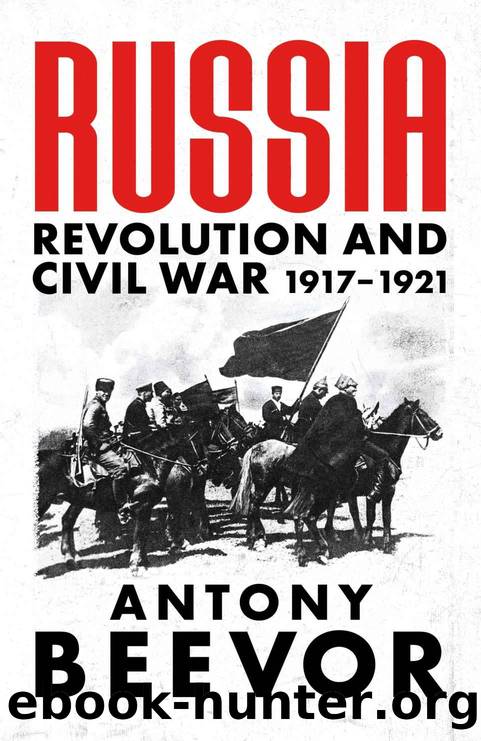Russia: Revolution and Civil War 1917-1921 by Antony Beevor

Author:Antony Beevor [Beevor, Antony]
Language: eng
Format: epub
Tags: History, Military, World War I, Russia & the Former Soviet Union, Europe, General
ISBN: 9781474610179
Google: JRdWEAAAQBAJ
Publisher: Orion
Published: 2022-05-25T19:00:00+00:00
Vladimir Lenin and Leon Trotsky (saluting) in Red Square 1919.
In the Baltic states, January 1919 saw the start of the fight-back against the Soviet 7th Army, which was some 8,000 strong. During the first week of January, the Estonian commander-in-chief General Laidoner used his new regiments to halt the advance of the Bolshevik forces. Then, on 7 January, the 1st Estonian Division in the north, supported by the Finnish volunteers and the new armoured train units, counter-attacked. Tapa was retaken two days later. Landings on the coast covered by the two captured destroyers surprised the Red forces and on 19 January, they were chased out of Narva by the Finns and student volunteers.
In the south on 14 January, Estonian armoured trains and the Kuperjanov Partisan Battalion forced the Reds to flee from Tartu, while the the 2nd Division launched its counter-offensive, seizing back Tõrva and Valga over the next two weeks. By the middle of February, Estonian territory was clear of Red Army forces.
The Latvian Provisional Government had not ordered general mobilisation until New Yearâs Eve, so it depended almost entirely on the German Landeswehr and 4,000 Freikorps volunteers from the 46th Saxon Division, consisting mainly of officers and soldiers embittered by the Armistice. On 2 January members of the government fled from Riga to the coast of Courland, hoping to find sanctuary on British warships. A counter-attack on 16 January with the 1st Independent Latvian Battalion, the German âIron Brigadeâ Freikorps and a White Russian battalion forced back the Red Latvian Rifle Division. This bought the Latvians time to increase their forces under their commander-in-chief JÄnis Balodis.
Alexander-Sinclairâs 6th Cruiser Squadron was replaced in the Baltic by Rear Admiral Walter Cowanâs 1st Light Cruiser Squadron. One of his destroyers, HMS Seafire, was captained by Commander Andrew Cunningham, the outstanding leader of the Royal Navy in the Second World War. Cowanâs force soon dominated the coastline, keeping the Red Baltic Fleet bottled up in the Kronstadt naval base and guarding the flank of the anti-Bolshevik forces in the region.
After their recapture of Pskov next to the Soviet-Estonian border, the Reds reported unexpected problems to Petrograd despite a âthorough cleansing of all counter-revolutionaries and enemies of the peopleâ. They found that engine drivers were âtraitorsâ and had deliberately sabotaged their locomotives. âMany of them had to be dragged from under their beds to be forced back to work. The sabotage of the engine drivers was a colossal blow to the Soviet authority, resulting in the loss of a thousand freight cars, either empty or loaded, as well as ninety-eight locomotives.â These railway workers were handed over to the Cheka. âThe black clique of engine drivers knew that communists have no mercy for counter-revolutionaries.â
Even more seriously, they were facing their third revolt in the Luga district as a result of Red Army troops looting the peasantsâ grain. In June of the year before, âthe cavalry detachment of Balakhovich, known for his drastic solutions, was particularly active in suppressing this uprising. For example Balakhovich and his men hacked to death whole villages with their sabres.
Download
This site does not store any files on its server. We only index and link to content provided by other sites. Please contact the content providers to delete copyright contents if any and email us, we'll remove relevant links or contents immediately.
The Radium Girls by Kate Moore(11970)
100 Deadly Skills by Clint Emerson(4879)
Rise and Kill First by Ronen Bergman(4739)
The Templars by Dan Jones(4656)
The Doomsday Machine by Daniel Ellsberg(4449)
The Rape of Nanking by Iris Chang(4165)
Killing England by Bill O'Reilly(3968)
Hitler in Los Angeles by Steven J. Ross(3923)
Stalin by Stephen Kotkin(3918)
12 Strong by Doug Stanton(3527)
Hitler's Monsters by Eric Kurlander(3291)
Blood and Sand by Alex Von Tunzelmann(3164)
The Code Book by Simon Singh(3136)
Darkest Hour by Anthony McCarten(3096)
The Art of War Visualized by Jessica Hagy(2973)
Hitler's Flying Saucers: A Guide to German Flying Discs of the Second World War by Stevens Henry(2731)
Babylon's Ark by Lawrence Anthony(2648)
The Second World Wars by Victor Davis Hanson(2502)
Tobruk by Peter Fitzsimons(2479)
